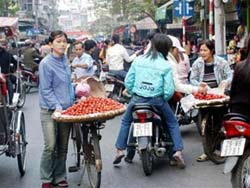Hanoi: Polluted winter air is higher than summer
This statement of Professor Pham Duy Hien, former Director of Da Lat Nuclear Institute also affirmed: the highest level of air pollution is in December, January, the lowest is July and August.
According to the author, the reason for this situation, because the winter usually has a northeast monsoon coming in, the air pressure increases, the temperature drops, causing the air to be confined, pollutants are difficult to spread and fly away. This makes pollutants close to the ground for a long time.

Air pollution in Hanoi is even heavier in winter.(Photo: Pham Yen)
Mr. Hien warned, because of the radiation, so in the winter, there was a phenomenon of inversing heat to the ground at night. Therefore, the Center for Hydro-meteorological Forecasting should study and forecast air quality at the time of inversion. By rising 100 meters, the temperature dropped by 0.6 degrees.
But when the heat-up occurs, the temperature increases with altitude, causing pollutants to not spread high but accumulate within 150-200 meters close to the ground.
This causes a spike in suspended particles of less than 1% millimeter (PM10). This type of dust easily penetrates into the respiratory tract of people, affecting health, especially those with age.
According to the observation results of Lang meteorological station (Northern Hydrometeorological Center Center), currently, every cubic meter of air in Hanoi has 80 mg of gas dust of PM10, 45 mg SO 2 , 30 mg NO 2 , 30 mg CO 2 , 30 mg 03 and 1000 mg CO.
When heat inversion occurs, most of these pollutants are elevated, in which gas dust increases the most.
- Hanoi: Winter, the most polluted season
- Hanoi winter moments
- Why is Hanoi hot in winter days?
- Why is Hanoi unusually hot in winter?
- Why is the summer feeling more persistent and uncomfortable than the winter?
- 37 days of clean air in the year, Hanoi is more polluted than Jakarta
- Please admire the poetic beauty of Hanoi winter
- Hanoi atmosphere 'dirty first in Asia'
- What is the Winter Olympics?
- Why about summer there are more stars than winter
- Winter will disappear in the North after a few years
- Summer temperatures will continue to be higher in the next 50 years
 Is the magnetic North Pole shift dangerous to humanity?
Is the magnetic North Pole shift dangerous to humanity? Washington legalizes the recycling of human bodies into fertilizer
Washington legalizes the recycling of human bodies into fertilizer Lightning stone - the mysterious guest
Lightning stone - the mysterious guest Stunned by the mysterious sunset, strange appearance
Stunned by the mysterious sunset, strange appearance Does air fryer cause cancer?
Does air fryer cause cancer?  New discovery about air fryer can change your mind
New discovery about air fryer can change your mind  How does air pollution increase the risk of infertility?
How does air pollution increase the risk of infertility?  The invention of the pearl diving submarine turned into a disaster
The invention of the pearl diving submarine turned into a disaster  Toxic smog has reached a 'new level'
Toxic smog has reached a 'new level'  An Asian city appears in 'season 5'
An Asian city appears in 'season 5' 